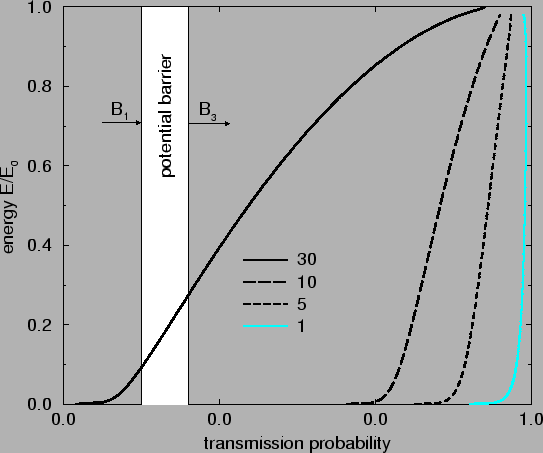



Next: 2.4.2 Tunnel Rate
Up: 2.4 Tunneling
Previous: 2.4 Tunneling
A wave packet with a probability amplitude B1 hits a potential barrier.
Part of the wave will be reflected and the rest will be transmitted through
the barrier. The probability amplitude of the transmitted part is
denoted by B3. The transmission probability |T|2 is defined as the
square of the ratio between transmitted and incoming probability amplitudes

The transmission probability can be derived from Schrödinger's equation

For a rectangular potential barrier with width d and height E0 it
is (see Appendix C.3 for a derivation)

For a typical strength parameter
![$d\sqrt{\smash[b]{2m^*E_0}}/\hbar$](img113.gif) of 30 the
transmission probability is shown in Fig. 2.4.
The strength parameter allows a classification of tunnel barriers according
to their opaqueness.
of 30 the
transmission probability is shown in Fig. 2.4.
The strength parameter allows a classification of tunnel barriers according
to their opaqueness.
Figure 2.4:
Transmission probability for a barrier with a strength parameter
of 30, 10, 5, and 1.
 |
A strength parameter of 1 is typical of the barriers present in
most ohmic contacts to semiconductors, a value of 5 is typical for the
ionization of an atom by an electric field and a value of 30 is characteristic
for the  -decay from a radioactive nucleus [47].
-decay from a radioactive nucleus [47].




Next: 2.4.2 Tunnel Rate
Up: 2.4 Tunneling
Previous: 2.4 Tunneling
Christoph Wasshuber

![]()

![]() of 30 the
transmission probability is shown in Fig. 2.4.
The strength parameter allows a classification of tunnel barriers according
to their opaqueness.
of 30 the
transmission probability is shown in Fig. 2.4.
The strength parameter allows a classification of tunnel barriers according
to their opaqueness.